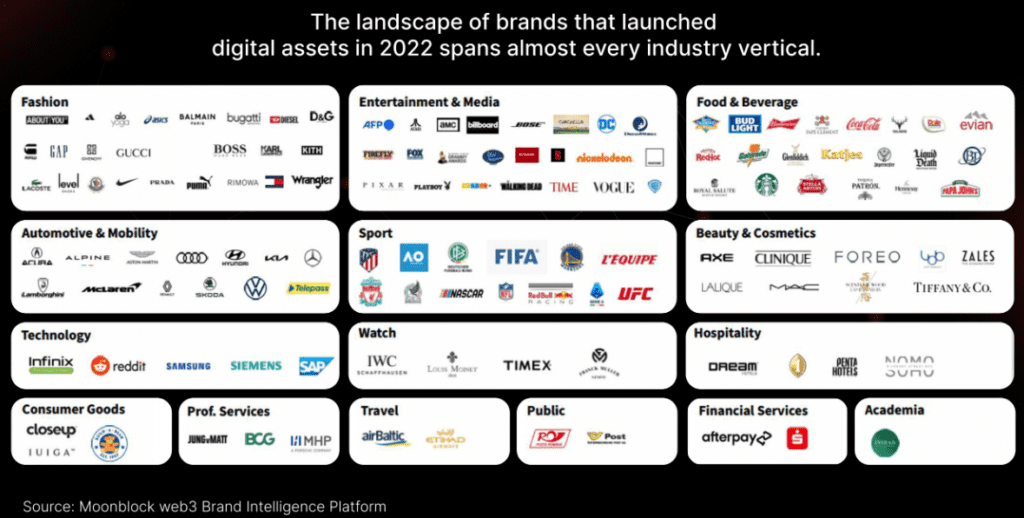Why is now the time to build toward a future where Darkblock powers the web3 content strategies for big brands and indie creators alike?
Because despite market conditions, web3 tech isn’t going anywhere. Companies like Disney, Mercedes-Benz, Canon, Mattel, Adidas, Amazon and Starbucks are still actively building in the web3 space, using the relative quiet of a down market to experiment with the tech and explore how they can incorporate web3 into their digital brand, content and customer-acquisition strategies.
Mercedes-Benz just this week announced it’s going all-in on web3, launching a dedicated entity called Mercedes-Benz NXT to drive its efforts in the space. On May 2, the company said in a tweet:
Enabled by the emergence of blockchain technologies, we believe digital art and collectibles will play an increasingly significant role in people’s online experience. Mercedes-Benz NXT marks a commitment to building a dedicated presence within the Web3 community.
Here’s a look at some of the brands that entered the web3 space last year:

Many of these web3 teams working for big brands will begin with digital collectibles, but they’ll be looking for ways to increase engagement, deliver value to their communities, and build brand loyalty. Content and its role as a vehicle in brand marketing and narrative storytelling is almost certain to be part of the strategic conversations. And when it is, Darkblock will be ready to provide a web3-native way to power those initiatives.
Here are some examples of big brands that are—despite the bear market—launching web3 initiatives, and how Darkblock may fit into their plans:
Mercedes-Benz
Mercedes-Benz is launching a web3 studio that will use blockchain tech to grow its digital brand and reach new audiences.
Darkblock use case: Deliver exclusive content and other digital assets to its community members via their NFTs, whether high-res printable images, metaverse assets, QR codes to redeem exclusive merch, etc.
Canon
Canon is preparing to launch a dedicated Photo NFT marketplace.
Darkblock use case: Use low-res images for the actual NFT, but use Darkblock to encrypt and attach high-res printable image files. Photographers such as Emanuele Ferrari, a well-known Italian fashion photographer, is currently using Darkblock to attach extra images from the photo shoot to his NFTs.
Amazon
The e-commerce behemoth is gearing up to enter the web3 space with its own NFT marketplace. If that’s not a sign of what’s to come, I don’t know what is.
Darkblock use case: If digital goods are going to be tokenized (not just JPEGs, but ebooks, audiobooks, gaming assets) and then bought and sold, there needs to be an encryption and access-control layer that protects the asset and ensures that only the current owner can access it.
Mattel
Mattel has been exploring how to leverage web3 tech with its stable of well-known IP, including Barbie and Hot Wheels NFT collections that both sold out.
Darkblock use case: These brands are launching collections to drive brand awareness and engage with new and existing audiences. By using their NFTs as deliver vehicles for exclusive content, whether storytelling assets, behind-the-scenes content, or even just QR codes for exclusive merch, they can open up new opportunities to engage with their audiences and grow brand loyalty.
Disney
Disney is finally bringing Star Wars to the blockchain. In collaboration with Cryptoys, a collection of Star Wars digital collectibles is dropping May 24.
Darkblock use case: Similar to Mattel, the Star Wars IP is ripe for exclusive web3 content that grows engagement and builds brand loyalty.
Adidas
Adidas was an early believer in web3, dropping its first NFT collection in late 2021 in collaboration with Bored Ape Yacht Club. That effort raised $23 million for the apparel brand, which hasn’t wavered since in its bet on the decentralized web—even because of current market conditions. It recently launched ALTS, which lets its holders burn NFTs from the original collection to redeem an Adidas avatar NFT (aka PFP) that’s tied into a bigger narrative campaign.
Darkblock use case: Narrative campaigns require ongoing storytelling content to keep audiences engaged.
Starbucks
Starbucks is using web3 tech to power its new customer-rewards program, Odyssey. The program lets customers earn and buy digital collectibles (ie, NFTs) that could unlock new virtual and IRL experiences. The program has proved so popular that just getting off the waitlist has been enough to generate a ton of free marketing as people share the milestone on Twitter and elsewhere.
Darkblock use case: Customer rewards program are all about… rewarding customers. Rather than airdrop new NFTs every time you want to reward customers, Darkblock could be used to deliver rewards via customers’ existing NFTs (eg, QR codes offering discounts on their next purchase).
Nike
Nike launched its own “web3-enabled platform” called .Swoosh for its fans “to learn about, collect and eventually help co-create virtual creations, which are typically interactive digital objects such as virtual shoes or jerseys.”
Darkblock use case: Nike has already said it plans to pair its NFTs with 3D files holders can use to “express themselves in new ways,” which is a perfect use case for Darkblock. By attaching 3D files to the NFTs (rather than a web2 approach), a brand such as Nike can ensure its fans that the files are immutable and will travel with the NFTs as they’re bought and sold. Attaching the 3D files via Darkblock would also provide the NFTs with future utility in metaverse or gaming contexts as the attached 3D wearable assets could be interacted with outside the confines of Nike’s website (which won’t be possible if Nike takes a traditional web2 or token-gated approach).
